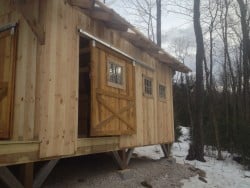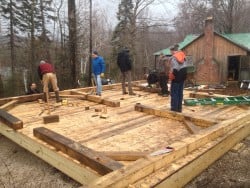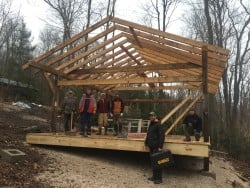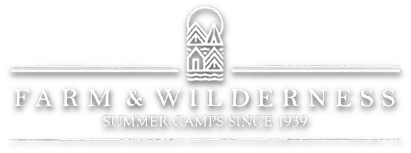
The aging Macobac trip shed at Saltash Mountain Camp has been rejuvenated, thanks to three Resource interns who spent a few months designing and rebuilding a timber-frame structure to replace the old one, which had outlived its useful life after years of use.
The Macobac, which stands for the “macaroni is out back”, was christened by campers in the summer of 1986. The shed is the main storage area for all SAM camp’s tents, stoves, gorp and other food for SAM trips. F&W’s three resource interns redesigned the shed based on what the camp director, Jeff Bounds, wanted to achieve.
A new Macobac design was created to provide a better trip pack-out experience for SAM campers. The improvements include a more accessible structure with more doors, better storage areas, and natural lighting. The new Macobac will be slightly larger, growing from 320-square- feet to 400-square-feet. Caged shelves will allow for easy access to trip food while keeping out any pesky critters.
In August, the Resource team held a basic timber-framing workshop when the interns successfully cut the frame. In October, they constructed the foundation and deck and then raised the frame.

Resource Intern Erik Biornstad of Portland, who has worked as a trips leader at Saltash Mountain Camp and will be the assistant director in 2016, said he found timber framing a unique way of building.
“Everyone needs to work together to bring the walls up – almost like the photos you see of Amish farm buildings going up. You are doing this together and no one is doing it on its own. It all comes together,” he said. “You’re communicating constantly and make sure people have physical or tool support. It feels very communal.”
This timber-frame building is held with wooden pegs – no screws are used on the frame. This is the same technique used to build the Barn Day Camp’s art barn and the new Sugar Shack behind Tamarack Farm.
“It was my first timber frame structure that I was able to be a part of in every step of the process. Designing the layout, cutting timbers, making doors – we helped do it all,” said Jeff Adams of Carlisle, PA. “The timber frame was much easier than conventional building – there are fewer pieces and you can put it to together like a puzzle.”
He plans to use these new skills when he travels soon to Moab, Utah to help build a straw bale house with a former boss. “I would like to adapt this to work with straw-bale building and then add the earthen plasters on the inside.”

The resource interns have recently completed the custom cabinets and doors for the Macobac, and they are finishing the shelving and a wheeled table for the pack outs. This was a great process for them to participate in the design and implementation of a project from start to finish, while advancing their construction and planning skills. The building will be completed in late January.
Additionally, all the timbers for the frame, siding and flooring were harvested and milled from spruce trees on the property. We hope that this well constructed building will serve SAM camp well for the next 50 years.
— Jay Kullman, Resource Director




